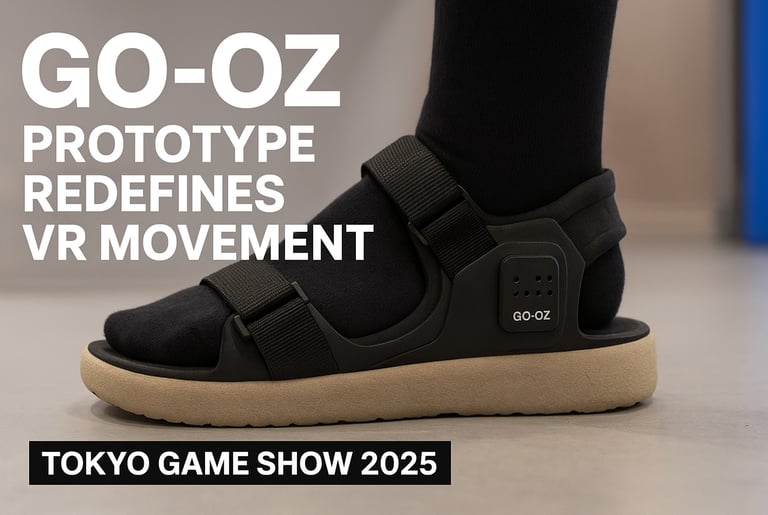GO-OZ VR Sandal Prototype Debuts at Tokyo Game Show 2025 | Next-Gen VR Movement Controller
The GO-OZ VR sandal, unveiled at Tokyo Game Show 2025, introduces natural foot-based movement in virtual reality. Learn how this wearable controller redefines VR locomotion, its benefits, challenges, and global patent details.
NEWS
Qasim
10/1/20252 min read


GO-OZ VR Sandal Prototype Redefines Virtual Reality Movement at Tokyo Game Show 2025
Tokyo, Japan – October 2025 — Virtual reality has long struggled with one major limitation: movement. Traditional VR experiences rely on handheld controllers, artificial teleportation, or treadmill-style platforms that often feel clunky, unnatural, and space-consuming. The newly unveiled GO-OZ prototype, introduced at the Tokyo Game Show 2025, promises to change that by bringing real walking sensations into digital spaces — without requiring a large physical play area.
A New Step Forward in VR Immersion
Unlike conventional VR movement systems, the GO-OZ wearable controller resembles a rugged sandal packed with advanced sensors. Instead of teleporting or using joystick inputs, players can simply lean forward to walk, shift backward to reverse, or tilt their feet to change direction. Subtle foot pressure, step length, and rhythm are tracked in real time, allowing users to experience natural locomotion while standing in a single spot.
This design not only enhances immersion but also solves one of the biggest barriers in VR adoption: limited living space. Users in small apartments, dorm rooms, or crowded environments can now experience full VR movement without worrying about bumping into walls or furniture.
How the GO-OZ Works
The device relies on a thick cushioned sole embedded with hypersensitive motion and pressure sensors. These sensors translate weight distribution and foot dynamics into precise in-game commands. Unlike step counters or simplified foot trackers, the GO-OZ detects micro-movements and subtle shifts, giving users an unparalleled sense of control.
Its adjustable strap system fits over regular shoes, while the foam-like base provides both comfort and stability. Because the device is worn rather than replacing footwear, players can slip them on quickly without altering their stance or balance — a thoughtful improvement over bulky treadmill setups.
Benefits for Longer VR Sessions
By simulating motion with natural but low-impact movements, the GO-OZ significantly reduces fatigue compared to constant walking or running in place. This makes it especially appealing for extended gaming sessions, VR training programs, or professional simulations. The balance between immersion and physical effort may encourage users to stay engaged in VR for longer without strain.
Challenges Ahead
Despite its promise, the GO-OZ remains an early prototype and faces technical hurdles before reaching mass production.
Latency issues: Any delay in detecting foot movement could cause disorientation or motion sickness.
Durability concerns: The device must handle daily wear, varying shoe types, and diverse body weights without losing accuracy.
Compatibility: To achieve widespread adoption, GO-OZ must integrate seamlessly with major VR headsets, engines, and games.
Currently, no official price point or release date has been confirmed, and the final design may evolve based on feedback from early testing.
Patent and Global Reach
The innovation is backed by an Industrial Invention Patent (No. 102018000003863), which covers wearable VR locomotion technology using foot input. The patent is jointly owned by three partners and registered across Italy, the European Union, the USA, and China, reflecting ambitions for global distribution.
Why the GO-OZ Matters
The GO-OZ represents more than just a new controller — it addresses one of VR’s most persistent problems: authentic, natural movement in confined spaces. If refined and successfully commercialized, this invention could become a cornerstone in the next generation of VR hardware, transforming how players explore virtual worlds and making immersive gaming accessible to a broader audience.
